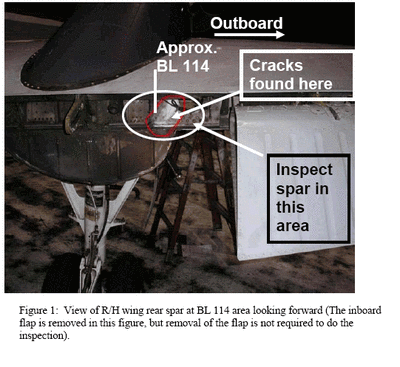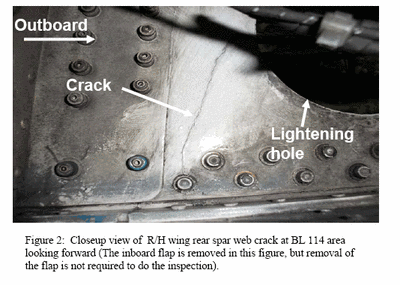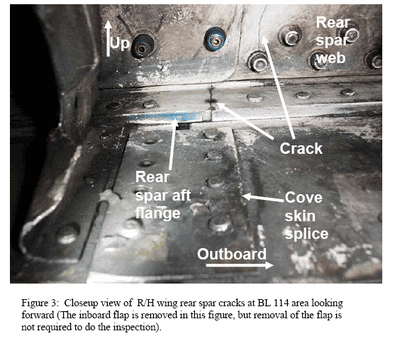Fri, Sep 01, 2006
Finds Cracking In Rear Wing Spars of D-Model Regional
Aircraft
Acting on reports of cracks found in the wings of two Raytheon
(Beechcraft) 1900D regional turboprops, the FAA has issued an
emergency airworthiness directive calling for the immediate visual
inspection of the left and right wing rear spar lower caps for
cracking, and other damage.

During routine maintenance of two 1900D airliners, the wing rear
spar lower caps and rear spar web were found to have significant
cracks. The Raytheon Aircraft Company Structural Inspection Manual
requires a thorough inspection of the wing rear spar at 17,500
hours time-in-service (TIS) with repetitive inspections at
intervals of 3,000 hours TIS.

One airplane had 19,126 hours TIS when cracks were found. The
cracks were in the lower aft spar cap flange, but the cracks
extended upward into the web and terminated at the lightening hole
in the spar web. Fasteners were also found missing in the spar cap
and wing cove splice plate. There were no discrepancies recorded
from the initial inspection at 17,500 hours TIS on this
airplane.
Early indications show similar cracking on the other airplane.
The FAA continues to gather information on this airplane.

Analysis shows that similar cracks could also develop in the
wings of the Models 1900 and 1900C airplanes.
FAA’s Determination
After careful review of all available information related to the
subject presented above, we have identified an unsafe condition
that is likely to exist or develop on other products of this same
type design. For this reason, the FAA has determined that AD action
should be taken to detect and correct cracking in the wing rear
spar lower caps of the affected airplanes before the cracks grow to
failure. Such a wing failure could result in the wing separating
from the airplane with consequent loss of control.

AD Requirements
This AD requires the following:
- A one-time visual inspection of both the left and right wing
rear spar lower caps for cracking and other damage such as loose or
missing fasteners.
- Repair of any cracks or damage found.
- Report of any cracks or damage found to the FAA and RAC.
- Provisions are included in this emergency AD to position the
airplane to a home base, hangar, maintenance facility, etc. with
limitations.
This is considered interim action. The FAA will use the data
from the reporting requirement to determine what additional action
is necessary, which could result in future AD action.
More News
“While legendary World War II aircraft such as the Corsair and P-51 Mustang still were widely flown at the start of the Korean War in 1950, a new age of jets rapidly came to >[...]
Decision Altitude (DA) A specified altitude (mean sea level (MSL)) on an instrument approach procedure (ILS, GLS, vertically guided RNAV) at which the pilot must decide whether to >[...]
Aero Linx: National Aviation Safety Foundation (NASF) The National Aviation Safety Foundation is a support group whose objective is to enhance aviation safety through educational p>[...]
Also: Cal Poly Aviation Club, $$un Country, Arkansas Aviation Academy, Teamsters Local 2118 In response to two recent general aviation accidents that made national headlines, more >[...]
“The FAA is tasked with ensuring our skies are safe, and they do a great job at it, but there is something about the system that is holding up the medical process. Obviously,>[...]
 Aero-News: Quote of the Day (04.28.25)
Aero-News: Quote of the Day (04.28.25) ANN's Daily Aero-Term (04.28.25): Decision Altitude (DA)
ANN's Daily Aero-Term (04.28.25): Decision Altitude (DA) ANN's Daily Aero-Linx (04.28.25)
ANN's Daily Aero-Linx (04.28.25) Airborne-Flight Training 04.24.25: GA Refocused, Seminole/Epic, WestJet v TFWP
Airborne-Flight Training 04.24.25: GA Refocused, Seminole/Epic, WestJet v TFWP Aero-News: Quote of the Day (04.29.25)
Aero-News: Quote of the Day (04.29.25)






